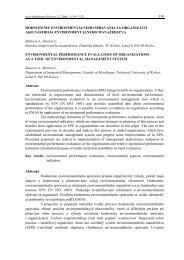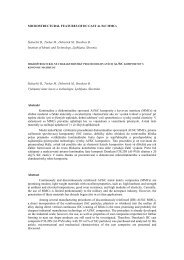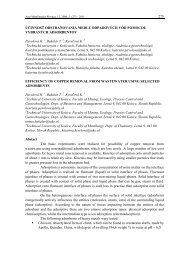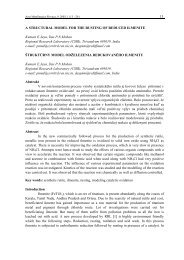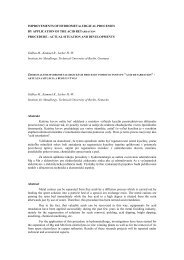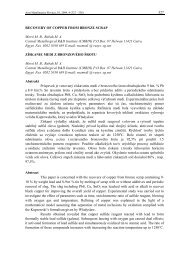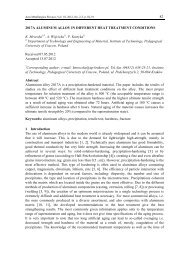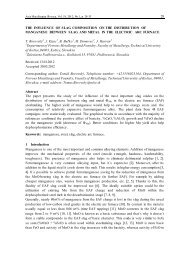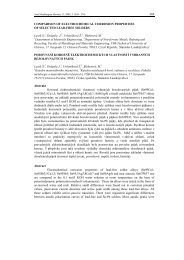165 the slag composition influence on the dephosphorization and ...
165 the slag composition influence on the dephosphorization and ...
165 the slag composition influence on the dephosphorization and ...
Create successful ePaper yourself
Turn your PDF publications into a flip-book with our unique Google optimized e-Paper software.
Acta Metallurgica Slovaca, Vol. 16, 2010, No.3, p. <str<strong>on</strong>g>165</str<strong>on</strong>g>-171 <str<strong>on</strong>g>165</str<strong>on</strong>g><br />
THE SLAG COMPOSITION INFLUENCE ON THE DEPHOSPHORIZATION AND ON<br />
THE LIFETIME OF ELECTRIC ARC FURNACE HEARTH REFRACTORY LINING<br />
T. Borovský 1 , J. Kijac 1 , M. Domovec 2<br />
1 Department of Ferrous Metallurgy <strong>and</strong> Foundry, Faculty of Metallurgy, Technical University<br />
of Košice,04001, Košice, Slovakia<br />
2 Železiarne Podbrezová a.s., Kolkáreň 35, 97681, Podbrezová, Slovakia<br />
Received 22.04.2010<br />
Accepted 14.11.2010<br />
Corresp<strong>on</strong>ding author: Tomáš Borovský, Teleph<strong>on</strong>e number: +4210556023164, Department of<br />
Ferrous Metallurgy <strong>and</strong> Foundry, Faculty of Metallurgy, Technical University of Košice, 04001,<br />
Park komenskeho 14, Košice, Slovakia, E-mail: Tomas.Borovsky@tuke.sk<br />
Abstract<br />
This study analyzes <str<strong>on</strong>g>the</str<strong>on</strong>g> <str<strong>on</strong>g>influence</str<strong>on</strong>g> of <str<strong>on</strong>g>the</str<strong>on</strong>g> <str<strong>on</strong>g>slag</str<strong>on</strong>g> <str<strong>on</strong>g>compositi<strong>on</strong></str<strong>on</strong>g> <strong>on</strong> <str<strong>on</strong>g>the</str<strong>on</strong>g> extent of EAF hearth refractory<br />
wear <strong>and</strong> especially <strong>on</strong> <str<strong>on</strong>g>the</str<strong>on</strong>g> dephosphorizati<strong>on</strong> effectiveness (expressed as practical phosphorus<br />
distributi<strong>on</strong> between <str<strong>on</strong>g>slag</str<strong>on</strong>g> <strong>and</strong> metal Φp). The statistical treatment of plant data from 24<br />
campaigns of EAF was c<strong>on</strong>ducted. It was found that increase of %CaO, basicity, CaO/FeO ratio<br />
<strong>and</strong> decrease of %FeO are beneficial both for lining protecti<strong>on</strong> <strong>and</strong> phosphorus removal. FeO<br />
c<strong>on</strong>tent must be optimized. Silica, alumina were low <strong>and</strong> improved <str<strong>on</strong>g>the</str<strong>on</strong>g> fluidity. Increasing of<br />
%MgO affected <str<strong>on</strong>g>the</str<strong>on</strong>g> wear positively, but Φp values negatively. Some negative factors could<br />
scatter <str<strong>on</strong>g>the</str<strong>on</strong>g> results.<br />
Keywords: electric arc furnace, dephosphorizati<strong>on</strong>, refractory wear, steel, <str<strong>on</strong>g>slag</str<strong>on</strong>g><br />
1 Introducti<strong>on</strong><br />
Modern EAF steelmaking technology is based <strong>on</strong> <str<strong>on</strong>g>the</str<strong>on</strong>g> utilizati<strong>on</strong> of basic oxidative <str<strong>on</strong>g>slag</str<strong>on</strong>g>s <strong>and</strong><br />
basic refractory materials (hearth: MgO or MgO-C) [1].<br />
Repair <strong>and</strong> replacement of damaged EAF hearth refractory lining represent significant financial<br />
investment, downtime <strong>and</strong> producti<strong>on</strong> losses. A lot of various factors participate <strong>on</strong> <str<strong>on</strong>g>the</str<strong>on</strong>g> hearth<br />
refractory wear process, however in different moments <strong>and</strong> EAF areas <str<strong>on</strong>g>the</str<strong>on</strong>g>y can act<br />
miscellaneously [1, 2, 3]. Slag line is <str<strong>on</strong>g>the</str<strong>on</strong>g> most critical area within <str<strong>on</strong>g>the</str<strong>on</strong>g> EAF hearth refractory<br />
lining [3, 4]. The <str<strong>on</strong>g>slag</str<strong>on</strong>g> chemically reacts with lining <strong>and</strong> dissolves magnesium oxide of <str<strong>on</strong>g>the</str<strong>on</strong>g> lining<br />
till <str<strong>on</strong>g>the</str<strong>on</strong>g> saturati<strong>on</strong> limit. That´s why CaO, MgO-based fluxes are added to <str<strong>on</strong>g>the</str<strong>on</strong>g> EAF in <str<strong>on</strong>g>the</str<strong>on</strong>g><br />
beginning of <str<strong>on</strong>g>the</str<strong>on</strong>g> heat. Calcium oxide is essential for phosphorus removal whilst magnesium<br />
oxide is necessary for refractory lining protecti<strong>on</strong> [5, 6]. The best case would be an achieving of<br />
dual saturati<strong>on</strong> point (saturati<strong>on</strong> of <str<strong>on</strong>g>slag</str<strong>on</strong>g> both with CaO <strong>and</strong> MgO), what would satisfy <str<strong>on</strong>g>slag</str<strong>on</strong>g><br />
foaming requirements as well [5, 7].<br />
Optimizati<strong>on</strong> of chemical <str<strong>on</strong>g>compositi<strong>on</strong></str<strong>on</strong>g> of EAF <str<strong>on</strong>g>slag</str<strong>on</strong>g> enables refractory wear decreasing <strong>and</strong> also<br />
improvement of <str<strong>on</strong>g>slag</str<strong>on</strong>g> refining ability. According to <str<strong>on</strong>g>the</str<strong>on</strong>g> <str<strong>on</strong>g>the</str<strong>on</strong>g>ory high values of phosphorus<br />
distributi<strong>on</strong> between <str<strong>on</strong>g>slag</str<strong>on</strong>g> <strong>and</strong> metal (i.e. (P 2 O 5 )/[P]) require higher basicities, lower SiO 2 , Al 2 O 3<br />
c<strong>on</strong>tents, minimal %P 2 O 5 <strong>and</strong> higher amount of ir<strong>on</strong> oxide [6, 8, 9, 10]. However %FeO in <str<strong>on</strong>g>the</str<strong>on</strong>g><br />
<str<strong>on</strong>g>slag</str<strong>on</strong>g> must be optimized – very low Φp values are documented at too low or too high oxidati<strong>on</strong><br />
potential of <str<strong>on</strong>g>the</str<strong>on</strong>g> <str<strong>on</strong>g>slag</str<strong>on</strong>g> (superoxidati<strong>on</strong>). The optimal %FeO is 20-35 wt% [8, 11]. MnO has
Acta Metallurgica Slovaca, Vol. 16, 2010, No.3, p. <str<strong>on</strong>g>165</str<strong>on</strong>g>-171 166<br />
negligible effect <strong>on</strong> dephosphorizati<strong>on</strong> process [12]. The <str<strong>on</strong>g>influence</str<strong>on</strong>g> of MgO is c<strong>on</strong>troversial –<br />
<str<strong>on</strong>g>the</str<strong>on</strong>g>re are various, sometimes nearly opposite opini<strong>on</strong>s [2, 13]. Beside of chemical <str<strong>on</strong>g>compositi<strong>on</strong></str<strong>on</strong>g><br />
<str<strong>on</strong>g>the</str<strong>on</strong>g>re are also o<str<strong>on</strong>g>the</str<strong>on</strong>g>r important factors facilitating phosphorus removal: lower temperature, larger<br />
c<strong>on</strong>tact area, l<strong>on</strong>ger tap-to-tap time, higher fluidity, bigger <str<strong>on</strong>g>slag</str<strong>on</strong>g> amount, intensifying agents<br />
additi<strong>on</strong> (e.g. Na 2 O), etc [8, 14, 15].<br />
The aim of this study was to investigate existing <str<strong>on</strong>g>slag</str<strong>on</strong>g> system from practice <strong>and</strong> to define <str<strong>on</strong>g>the</str<strong>on</strong>g><br />
optimal <str<strong>on</strong>g>compositi<strong>on</strong></str<strong>on</strong>g> of <str<strong>on</strong>g>the</str<strong>on</strong>g> EAF <str<strong>on</strong>g>slag</str<strong>on</strong>g> in order to improve dephosphorizati<strong>on</strong> effectiveness <strong>and</strong><br />
help to protect <str<strong>on</strong>g>the</str<strong>on</strong>g> EAF refractory lining.<br />
2 Experimental methods<br />
The <str<strong>on</strong>g>influence</str<strong>on</strong>g> of <str<strong>on</strong>g>the</str<strong>on</strong>g> most important <str<strong>on</strong>g>slag</str<strong>on</strong>g> c<strong>on</strong>stituents (CaO, MgO, FeO, MnO, SiO 2 , Al 2 O 3 ) <strong>on</strong><br />
<str<strong>on</strong>g>the</str<strong>on</strong>g> lifetime of EAF hearth refractory lining <strong>and</strong> <strong>on</strong> <str<strong>on</strong>g>the</str<strong>on</strong>g> dephosphorizati<strong>on</strong> effectiveness was<br />
graphically investigated by using statistical analysis of EAF plant data (metal <strong>and</strong> <str<strong>on</strong>g>slag</str<strong>on</strong>g><br />
<str<strong>on</strong>g>compositi<strong>on</strong></str<strong>on</strong>g>s, refractory wear levels, practical phosphorus distributi<strong>on</strong> i.e. Φp values). There<br />
were 24 EAF campaigns evaluated. Refractory wear levels (MgO-C<br />
Table 1 The arrangement of selected parameters according to increasing wear level<br />
Point Refractory wear CaO Al 2 O 3 SiO 2 MgO MnO FeO Φp<br />
No. (cm/heat) (wt%) (wt%) (wt%) (wt%) (wt%) (wt%)<br />
● 1 0.060 18.43 4.15 12.40 6.19 5.81 44.24 51.87<br />
● 2 0.063 23.91 4.03 12.19 3.38 5.63 39.23 62.67<br />
● 3 0.068 30.05 6.19 12.51 2.40 5.20 32.53 113.62<br />
● 4 0.073 19.86 4.84 13.37 5.25 5.35 42.47 63.88<br />
● 5 0.075 31.40 5.12 14.50 2.70 5.18 30.44 114.77<br />
● 6 0.076 34.40 5.13 14.96 2.68 5.06 27.53 112.53<br />
● 7 0.076 28.87 4.97 13.57 3.12 5.71 32.47 77.90<br />
● 8 0.076 23.11 3.86 12.48 4.50 5.53 40.60 61.00<br />
● 9 0.086 33.27 5.13 13.79 2.21 4.78 29.40 113.56<br />
● 10 0.086 31.09 5.83 12.91 1.86 5.31 30.99 110.25<br />
● 11 0.089 28.37 6.08 13.46 2.17 5.37 33.23 88.31<br />
● 12 0.095 30.11 6.35 13.67 2.03 5.56 31.20 94.92<br />
○ 13 0.103 21.03 3.74 11.23 3.39 5.43 44.59 55.82<br />
○ 14 0.106 20.62 3.21 9.84 2.94 5.23 46.36 52.80<br />
○ 15 0.107 26.72 4.02 12.08 3.20 5.35 36.64 78.39<br />
○ 16 0.109 18.59 4.30 10.63 3.89 5.71 46.15 52.26<br />
○ 17 0.111 25.40 4.02 11.14 2.32 5.21 39.37 59.07<br />
○ 18 0.113 17.45 3.06 9.72 4.31 4.83 50.56 43.50<br />
○ 19 0.117 20.68 3.28 10.98 3.03 5.26 45.96 55.39<br />
○ 20 0.119 24.66 5.12 11.39 4.35 5.08 38.68 65.59<br />
○ 21 0.130 24.68 2.91 9.21 2.39 4.38 43.18 65.05<br />
○ 22 0.130 19.71 3.44 11.00 2.90 5.32 47.23 55.84<br />
○ 23 0.132 19.36 3.11 9.17 2.79 5.48 49.29 60.29<br />
○ 24 0.133 20.18 3.54 10.79 2.74 5.16 45.95 51.26<br />
bricks) were calculated as differences between new <strong>and</strong> spent bricks <strong>and</strong> relating it to number of<br />
heats (acquired data in cm per heat). The data were arranged to <str<strong>on</strong>g>the</str<strong>on</strong>g> table according to increasing<br />
wear level (see Table 1). Wears above 0,1 cm/heat were c<strong>on</strong>sidered as excessive (12 dark <strong>and</strong><br />
12 light marked campaigns). The average values of parameters per campaign were used. The<br />
phosphorus distributi<strong>on</strong> parameter Φp was calculated as Φp = (P 2 O 5 )/[P]. Slag <strong>and</strong> metal were
Acta Metallurgica Slovaca, Vol. 16, 2010, No.3, p. <str<strong>on</strong>g>165</str<strong>on</strong>g>-171 167<br />
manually sampled by EAF operator from <str<strong>on</strong>g>the</str<strong>on</strong>g> <str<strong>on</strong>g>slag</str<strong>on</strong>g> door area approximately at temperatures ~<br />
1550 – 1560°C, 7-12 minutes before EAF tapping. The <str<strong>on</strong>g>slag</str<strong>on</strong>g> samples were analyzed by X-ray<br />
spectrometer. Results could be affected by negative factors such as: human factor, sample<br />
c<strong>on</strong>taminati<strong>on</strong> (c<strong>on</strong>sequences of manual sampling), use of oxygen jet before sampling, vicinity<br />
of oxy-fuel burner, etc. For most cases <str<strong>on</strong>g>the</str<strong>on</strong>g> critical wear was indicated in <str<strong>on</strong>g>the</str<strong>on</strong>g> locati<strong>on</strong> under <str<strong>on</strong>g>the</str<strong>on</strong>g><br />
sill level (c<strong>on</strong>sequence of oxygen jet usage).<br />
3 Analysis of <str<strong>on</strong>g>the</str<strong>on</strong>g> results<br />
3.1 Refractory wear <strong>and</strong> dephosphorizati<strong>on</strong> as functi<strong>on</strong>s of <str<strong>on</strong>g>the</str<strong>on</strong>g> complex <str<strong>on</strong>g>slag</str<strong>on</strong>g> <str<strong>on</strong>g>compositi<strong>on</strong></str<strong>on</strong>g><br />
Owing to better underst<strong>and</strong>ing, <str<strong>on</strong>g>the</str<strong>on</strong>g> data were plotted to <str<strong>on</strong>g>the</str<strong>on</strong>g> secti<strong>on</strong> of <str<strong>on</strong>g>the</str<strong>on</strong>g> pseudoternary diagram<br />
(Fig.1), which illustrates <str<strong>on</strong>g>the</str<strong>on</strong>g> relati<strong>on</strong>ship of basic, acidic oxides <strong>and</strong> oxides with oxidati<strong>on</strong><br />
potential. Each campaign was marked with point (rising number means higher wear level).<br />
Three different z<strong>on</strong>es marked A, B, C were chosen.<br />
Fig.1 Pseudoternary diagram (CaO + MgO) - (FeO + MnO) - (SiO 2 + Al 2O 3 + TiO 2 + P 2O 5) with plotted wear levels<br />
<strong>and</strong> practical phosphorus distributi<strong>on</strong> values Φp.<br />
The campaigns with low wear levels <strong>and</strong> high Φp values (No. 3, 5, 6, 7, 9, 10, 11, 12) were<br />
cumulated in <str<strong>on</strong>g>the</str<strong>on</strong>g> A-marked regi<strong>on</strong> (wear ~ 0.082 cm/heat, Φp ~ 103,23 <strong>on</strong> average), whilst <str<strong>on</strong>g>the</str<strong>on</strong>g><br />
campaigns with high wear levels <strong>and</strong> low Φp values (points No. 13, 14, 16, 18, 19, 22, 23, 24)<br />
were clustered in <str<strong>on</strong>g>the</str<strong>on</strong>g> C-marked regi<strong>on</strong> (wear ~ 0.118 cm/heat, Φp ~ 53,40 <strong>on</strong> average). Regi<strong>on</strong><br />
marked B represents regi<strong>on</strong> in <str<strong>on</strong>g>the</str<strong>on</strong>g> middle, where both low <strong>and</strong> high wear levels <strong>and</strong> Φp values<br />
were present (wear ~ 0.092 cm/heat, Φp ~ 63,44 <strong>on</strong> average). It´s clear that Φp values are<br />
gradually rising in <str<strong>on</strong>g>the</str<strong>on</strong>g> directi<strong>on</strong> of %(CaO + MgO) increasing <strong>and</strong> %(FeO + MnO) decreasing.
Acta Metallurgica Slovaca, Vol. 16, 2010, No.3, p. <str<strong>on</strong>g>165</str<strong>on</strong>g>-171 168<br />
Φp values in A-regi<strong>on</strong> are in comparis<strong>on</strong> to those in C-regi<strong>on</strong> nearly double. It´s explained by<br />
<str<strong>on</strong>g>the</str<strong>on</strong>g> fact, that despite of a bit higher acidic oxides c<strong>on</strong>tent (+5,7%), in A-regi<strong>on</strong> are <str<strong>on</strong>g>the</str<strong>on</strong>g> highest<br />
basic oxides c<strong>on</strong>centrati<strong>on</strong>s <strong>and</strong> relatively optimal oxidati<strong>on</strong> c<strong>on</strong>diti<strong>on</strong>s of <str<strong>on</strong>g>the</str<strong>on</strong>g> <str<strong>on</strong>g>slag</str<strong>on</strong>g> (~ 36,4 wt<br />
%CaO+MgO, ~ 31,0 wt %FeO <strong>on</strong> average). EAF refractory wear issue was solved in previous<br />
article [3]: It was found that %FeO growth has <str<strong>on</strong>g>the</str<strong>on</strong>g> worst <str<strong>on</strong>g>influence</str<strong>on</strong>g> <strong>on</strong> <str<strong>on</strong>g>the</str<strong>on</strong>g> lining. Increasing of<br />
basicity, CaO, MgO c<strong>on</strong>tents has positive effect <strong>on</strong> <str<strong>on</strong>g>the</str<strong>on</strong>g> lining life. Silica increases <str<strong>on</strong>g>the</str<strong>on</strong>g> wear when<br />
its c<strong>on</strong>tent exceeds 14 wt%, alumina accelerates <str<strong>on</strong>g>the</str<strong>on</strong>g> wear above 5 wt% of Al 2 O 3 c<strong>on</strong>tent in <str<strong>on</strong>g>the</str<strong>on</strong>g><br />
EAF <str<strong>on</strong>g>slag</str<strong>on</strong>g>. Paradoxically, <str<strong>on</strong>g>the</str<strong>on</strong>g> highest wear levels were detected at low SiO 2 ,Al 2 O 3<br />
c<strong>on</strong>centrati<strong>on</strong>s.<br />
3.2 Graphical relati<strong>on</strong>ships - Φp as a functi<strong>on</strong> of <str<strong>on</strong>g>slag</str<strong>on</strong>g> <str<strong>on</strong>g>compositi<strong>on</strong></str<strong>on</strong>g><br />
Graphical relati<strong>on</strong>ship of phosphorus distributi<strong>on</strong> between <str<strong>on</strong>g>slag</str<strong>on</strong>g> <strong>and</strong> metal versus %CaO showed<br />
(Fig.2) in accordance with <str<strong>on</strong>g>the</str<strong>on</strong>g>ory that rising calcium oxide c<strong>on</strong>tent significantly intensifies<br />
phosphorus removal. However graph of phosphorus distributi<strong>on</strong> versus %MgO c<strong>on</strong>tent suggests<br />
(Fig.3, remarkably lower R 2 coefficient value), that increasing of magnesium oxide c<strong>on</strong>tent is<br />
detrimental. The reas<strong>on</strong> of this fact is <str<strong>on</strong>g>the</str<strong>on</strong>g> decreasing of <str<strong>on</strong>g>the</str<strong>on</strong>g> activity of CaO [2].<br />
Fig.2 Φp as a functi<strong>on</strong> of %CaO in <str<strong>on</strong>g>the</str<strong>on</strong>g> EAF <str<strong>on</strong>g>slag</str<strong>on</strong>g><br />
Fig.3 Φp as a functi<strong>on</strong> of %MgO in <str<strong>on</strong>g>the</str<strong>on</strong>g> EAF <str<strong>on</strong>g>slag</str<strong>on</strong>g>.<br />
Fig.4 Φp as a functi<strong>on</strong> of %SiO 2 in <str<strong>on</strong>g>the</str<strong>on</strong>g> EAF <str<strong>on</strong>g>slag</str<strong>on</strong>g><br />
Fig.5 Φp as a functi<strong>on</strong> of %Al 2O 3 in <str<strong>on</strong>g>the</str<strong>on</strong>g> EAF <str<strong>on</strong>g>slag</str<strong>on</strong>g>.<br />
The dependencies of Φp versus acidic oxides are illustrated <strong>on</strong> <str<strong>on</strong>g>the</str<strong>on</strong>g> Fig.4, Fig.5. It was supposed<br />
that Φp will rise both with decreasing %SiO 2 , %Al 2 O 3 c<strong>on</strong>tent. The graphs showed improved<br />
dephosphorizati<strong>on</strong> with increase of %SiO 2 , %Al 2 O 3 . Similar phenomena were observed within<br />
<str<strong>on</strong>g>the</str<strong>on</strong>g> refractory wear [3]. It´s explained by <str<strong>on</strong>g>the</str<strong>on</strong>g> fact that Al 2 O 3 , SiO 2 levels in EAF <str<strong>on</strong>g>slag</str<strong>on</strong>g> were<br />
sufficiently low <strong>and</strong> could increase fluidity of <str<strong>on</strong>g>the</str<strong>on</strong>g> <str<strong>on</strong>g>slag</str<strong>on</strong>g>. It´s well known that Al 2 O 3 acts as<br />
fluidizing agent in CaO - FeO x - SiO 2 system. The abrupt increase of <str<strong>on</strong>g>slag</str<strong>on</strong>g> viscosity in CaO -<br />
FeO x - SiO 2 system is observed above 50 wt % SiO 2 [8, 16, 17].
Acta Metallurgica Slovaca, Vol. 16, 2010, No.3, p. <str<strong>on</strong>g>165</str<strong>on</strong>g>-171 169<br />
Fig.6 Φp as a functi<strong>on</strong> of %FeO 2 in <str<strong>on</strong>g>the</str<strong>on</strong>g> EAF <str<strong>on</strong>g>slag</str<strong>on</strong>g><br />
Fig.7 Φp as a functi<strong>on</strong> of %CaO/%FeO ratio.<br />
MnO c<strong>on</strong>tent in analyzed EAF <str<strong>on</strong>g>slag</str<strong>on</strong>g>s varied <strong>on</strong>ly in ~ 4 –6 wt% range <strong>and</strong> its effect <strong>on</strong> <str<strong>on</strong>g>the</str<strong>on</strong>g> Φp<br />
values is assumed to be negligible. The dependence of Φp versus ir<strong>on</strong> oxide c<strong>on</strong>tent<br />
dem<strong>on</strong>strated str<strong>on</strong>g negative <str<strong>on</strong>g>influence</str<strong>on</strong>g> of high %FeO c<strong>on</strong>centrati<strong>on</strong>s <strong>on</strong> <str<strong>on</strong>g>the</str<strong>on</strong>g> dephosphorizati<strong>on</strong><br />
(Fig.6). The same detrimental effect was seen at refractory wear vs. %FeO relati<strong>on</strong>ship – see [3].<br />
The lowest average FeO c<strong>on</strong>tent in <str<strong>on</strong>g>the</str<strong>on</strong>g> EAF <str<strong>on</strong>g>slag</str<strong>on</strong>g> was 27,5 wt% <strong>and</strong> <str<strong>on</strong>g>the</str<strong>on</strong>g> highest Φp values are<br />
cumulated in <str<strong>on</strong>g>the</str<strong>on</strong>g> ~ 27-33 wt%FeO range. The <str<strong>on</strong>g>slag</str<strong>on</strong>g>s high in %FeO are superoxidized. Since both<br />
FeO <strong>and</strong> CaO are necessary for dephosphorizati<strong>on</strong>, effect of <str<strong>on</strong>g>the</str<strong>on</strong>g>ir own relati<strong>on</strong>ship (CaO/FeO<br />
ratio) <strong>on</strong> <str<strong>on</strong>g>the</str<strong>on</strong>g> Φp was studied (Fig.7). This graph clearly proved primary positi<strong>on</strong> of CaO in <str<strong>on</strong>g>the</str<strong>on</strong>g><br />
dephosphorizati<strong>on</strong> process.<br />
Fig.8 Φp as a functi<strong>on</strong> of basicity B 2 <strong>and</strong> oxidati<strong>on</strong> potential of EAF <str<strong>on</strong>g>slag</str<strong>on</strong>g>.<br />
Finally, <str<strong>on</strong>g>the</str<strong>on</strong>g> three-dimensi<strong>on</strong>al quadratic graph of phosphorus distributi<strong>on</strong> as a functi<strong>on</strong> of binary<br />
basicity (B 2 = CaO/SiO 2 ) <strong>and</strong> oxidati<strong>on</strong> potential of <str<strong>on</strong>g>the</str<strong>on</strong>g> <str<strong>on</strong>g>slag</str<strong>on</strong>g> was c<strong>on</strong>sidered (Fig.8). There´s a
Acta Metallurgica Slovaca, Vol. 16, 2010, No.3, p. <str<strong>on</strong>g>165</str<strong>on</strong>g>-171 170<br />
clear change of Φp values within %(FeO+MnO) decline. High Φp values are c<strong>on</strong>centrated at<br />
lower %(FeO+MnO), whereas maximal Φp values are present in high basicity area. The EAF<br />
technology should be managed in <str<strong>on</strong>g>the</str<strong>on</strong>g> way: ~ 30 wt% FeO <strong>and</strong> B 2 ~ 2,8.<br />
4 C<strong>on</strong>clusi<strong>on</strong>s<br />
Presented article deals about effect of EAF <str<strong>on</strong>g>slag</str<strong>on</strong>g> <str<strong>on</strong>g>compositi<strong>on</strong></str<strong>on</strong>g> <strong>on</strong> <str<strong>on</strong>g>the</str<strong>on</strong>g> refractory wear <strong>and</strong><br />
dephosphorizati<strong>on</strong> effectiveness. The plant data from 24 EAF campaigns were statistically<br />
treated. The illustrati<strong>on</strong> of studied campaigns in pseudoternary diagram as well as graphical<br />
relati<strong>on</strong>ships showed negativity of high FeO c<strong>on</strong>tent <strong>on</strong> both wear <strong>and</strong> dephosphorizati<strong>on</strong><br />
processes. Opposite effect had increasing of %CaO, basicity. Silica <strong>and</strong> alumina improved<br />
fluidity <strong>and</strong> so <str<strong>on</strong>g>the</str<strong>on</strong>g> phosphorus removal (<str<strong>on</strong>g>the</str<strong>on</strong>g>ir c<strong>on</strong>tent in <str<strong>on</strong>g>the</str<strong>on</strong>g> EAF <str<strong>on</strong>g>slag</str<strong>on</strong>g> was low). %MgO acts<br />
positively <strong>on</strong> <str<strong>on</strong>g>the</str<strong>on</strong>g> lining, but negatively <strong>on</strong> <str<strong>on</strong>g>the</str<strong>on</strong>g> Φp. Thus it´s very important for EAF technology<br />
to manage <str<strong>on</strong>g>the</str<strong>on</strong>g> %FeO c<strong>on</strong>tent (optimum ~ 27-33 wt%), acquire <str<strong>on</strong>g>the</str<strong>on</strong>g> high basicity <strong>and</strong> optimize <str<strong>on</strong>g>the</str<strong>on</strong>g><br />
MgO c<strong>on</strong>tent. The c<strong>on</strong>tent of acidic oxides should be in <str<strong>on</strong>g>the</str<strong>on</strong>g> level which doesn´t deteriorate <str<strong>on</strong>g>the</str<strong>on</strong>g><br />
fluidity of <str<strong>on</strong>g>the</str<strong>on</strong>g> <str<strong>on</strong>g>slag</str<strong>on</strong>g>. It´s important to menti<strong>on</strong> <str<strong>on</strong>g>the</str<strong>on</strong>g> possible negative factors that could scatter <str<strong>on</strong>g>the</str<strong>on</strong>g><br />
obtained results: manual sampling, sample c<strong>on</strong>taminati<strong>on</strong>, oxygen jet using, vicinity of oxy-fuel<br />
burner, etc., but almost within all <str<strong>on</strong>g>the</str<strong>on</strong>g> graphs (with excepti<strong>on</strong> of Φp = f(%MgO) functi<strong>on</strong>) high<br />
values of R 2 coefficient were acquired (i.e. R 2 above ~ 0,6).<br />
References<br />
[1] P. Raschman: Acta metallurgica slovaca, Vol.6, 2000, p. 69-76 (in Slovak).<br />
[2] K.C. Mills, Y. Su, A.B. Fox, Z. Li, R.P. Thackray, H.T. Tsai: ISIJ Internati<strong>on</strong>al, Vol. 45,<br />
2005, No.5, p. 619-633.<br />
[3] T. Borovský, J. Kijac, M. Domovec: Acta Metallurgica Slovaca, Vol. 15, 2009, No. 2,<br />
p.77-85.<br />
[4] Z. Li, K. Mukai, Z. Tao: ISIJ Internati<strong>on</strong>al, Vol. 40, 2000, Suplement, p. S101-S105.<br />
[5] E. Pretorius, R.C. Carlisle: Ir<strong>on</strong> & Steelmaker, Vol. 26, 1999, No.10, p. 79-88.<br />
[6] T. Borovský: Optimizati<strong>on</strong> of <str<strong>on</strong>g>the</str<strong>on</strong>g> lime amount added in <str<strong>on</strong>g>the</str<strong>on</strong>g> dephosphorizati<strong>on</strong> period of <str<strong>on</strong>g>the</str<strong>on</strong>g><br />
steel, Metalurgia Junior´09 C<strong>on</strong>ference, Košice, 2009, ISBN 978-80-553-0250-8 (in<br />
Slovak).<br />
[7] M. Novák, J. Bulín, M. Přibyl, R. Heide, J. Straka: The experience with foamy <str<strong>on</strong>g>slag</str<strong>on</strong>g><br />
technology introducti<strong>on</strong> in producti<strong>on</strong> of clean <strong>and</strong> superclean steels at c<strong>on</strong>diti<strong>on</strong>s of Pilsen<br />
Steel Steelmill, 22 nd state c<strong>on</strong>ference with foreign participati<strong>on</strong>, Rožnov pod Radhoštěm,<br />
Tanger, 2008, p. 216-226 (in Czech).<br />
[8] G. Li, T. Hamano, F. Tsukihashi: ISIJ Internati<strong>on</strong>al, Vol.45, 2005, No.1, p.12-18.<br />
[9] H. Ishii, R.J. Fruehan: Ir<strong>on</strong> & Steelmaker, Vol. 24, 1997, No. 2, p. 47-54.<br />
[10] E.T. Turkdogan: ISIJ Internati<strong>on</strong>al, Vol. 40, 2000, No. 9, p. 827-832.<br />
[11] R.J. Fruehan, C.P. Manning: Final Report, AISI/DOE Technology roadmap program,<br />
American Ir<strong>on</strong> <strong>and</strong> Steel Institute, Pittsburgh, 2001.<br />
[12] A.T. Morales, R.J. Fruehan: Metallurgical And Materials Transacti<strong>on</strong>s B, Vol. 28, 1997,<br />
No.6, p. 1111-1118.<br />
[13] Z. Adolf, P. Suchánek, T. Gumulec, R. Sikora: The oxidic flux <str<strong>on</strong>g>influence</str<strong>on</strong>g> <strong>on</strong> <str<strong>on</strong>g>the</str<strong>on</strong>g> steel<br />
dephosphorizati<strong>on</strong> process, 22 nd state c<strong>on</strong>ference with foreign participati<strong>on</strong>, Rožnov pod<br />
Radhoštěm, Tanger, 2006, p. 68-74 (in Czech).
Acta Metallurgica Slovaca, Vol. 16, 2010, No.3, p. <str<strong>on</strong>g>165</str<strong>on</strong>g>-171 171<br />
[14] M. Swinnert<strong>on</strong>: The <str<strong>on</strong>g>influence</str<strong>on</strong>g> of <str<strong>on</strong>g>slag</str<strong>on</strong>g> evoluti<strong>on</strong> <strong>on</strong> BOF dephosphorisati<strong>on</strong>, Thesis,<br />
University of Woll<strong>on</strong>g<strong>on</strong>g, New South Wales, Australia, 2005.<br />
[15] J.J. Pak, R.J. Fruehan: Metallurgical transacti<strong>on</strong>s B, Vol. 22, 1991, Issue 1, p. 39-46.<br />
[16] M. Nakamoto, J. Lee, T. Tanaka: ISIJ Int., Vol. 45, 2005, No.5, p. 651-656.<br />
[17] T. Hamano, M. Horibe, K. Ito: ISIJ Int., Vol.44, 2004, No.2, p. 263-267.



